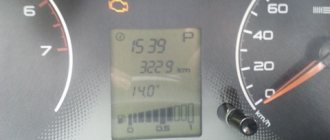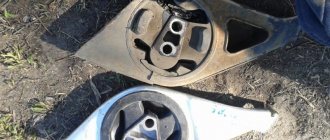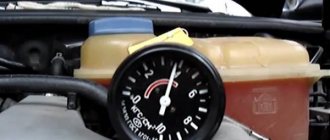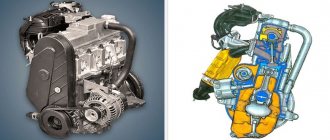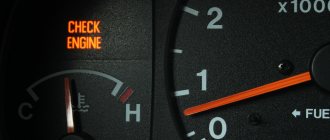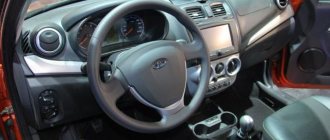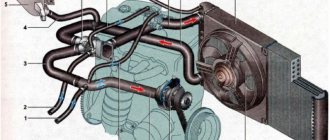Many Lada Kalina car owners have encountered the “CHECK” icon lighting up on the instrument panel. This is primarily due to the fact that the engine has failed. Not everyone knows how to determine a malfunction, so in this article we will look at the causes and possible solutions to the problem.
Video about engine malfunctions in which the “CHECK” light comes on on the Lada Kalina:
The video material will tell you what to do when the check engine light comes on, and also indicate the reasons and solutions.
Failure of the fuel tank, failure of the neutralizer
When the check engine light comes on, the owner of a Lada Kalina with an 8-valve engine first of all aims to find faults directly in the engine. However, the reason can sometimes “lurk” elsewhere. The glow of the symbol is caused by a loss of tightness in the fuel circuit. Even a loose tank cap can cause this situation.
Depressurization of the system involves the penetration of an additional portion of air into the circuit. In this case, a symptom such as an increase in fuel consumption appears, and the correct functioning of the engine itself is also disrupted.
When the owner of a Lada Kalina does not detect any extraneous sounds in the engine or other deviations in its operation, but the lamp on the dashboard still continues to glow, then the first step is to make sure that the gas tank cap is tight. Quite often there are situations in which drivers, in a frantic rush, forget to check that the cap is correctly and securely seated after refueling.
If after such a check the lamp on the dashboard “refuses” to go out, then you need to continue searching for other reasons. What to do when the catalyst “announces” its malfunction? This important component of the exhaust system serves to neutralize the flow of exhaust gases. It is no secret that a huge number of substances harmful to the surrounding atmosphere accumulate in the exhaust system during engine operation. Due to the presence and functioning of the neutralizer, the level of their emissions is reduced significantly.
Among the main signs of a breakdown of the catalyst in Lada Kalina, 2 experts highlight the factor of reduced engine power. This also manifests itself in worsening dynamics.
As already noted, a common reason for the neutralizer to become unusable is the breakdown of the lambda probe in the Lada Kalina 2. Also, worn-out spark plugs can significantly shorten the “life” of the exhaust circuit element considered here.
As a result of the influence of these factors, a significant decrease in the effect of gas neutralization is observed. Oxides accumulate inside the component, which over time leads to overheating and the risk of catalyst destruction. Operating a car with such a breakdown is undesirable, since incorrect operation of the engine will not allow the unit to develop the declared characteristics. Over time, a neutralizer that has become unusable can cause damage to the power plant, so timely replacement of this component is a more rational and cheaper measure compared to engine overhaul. To replace it, you will need to contact a service center, since it is unlikely that you will be able to carry out the repair procedure yourself.
Let us remind you that the keys to a long service life of the neutralizer are:
- timely replacement of spark plugs;
- use of high-quality fuel;
- correct operation of the lambda probe.
Another factor if the check light is on is the failure of the sensor responsible for the mass flow of air sucked into the intake manifold. This malfunction is characterized by a decrease in the engine power level and the failure of the unit to start smoothly when cold.
Why can the mass air flow sensor fail? One of the reasons for this annoying situation is the untimely replacement of the filter element in the air intake circuit. The motor itself is unlikely to suffer from a faulty state of the sensor, other than the indicated loss of power parameter. However, the owner will refuel more, due to the increase in consumption provoked by this fact. The price of the mass air flow sensor is not exorbitant, so it is not advisable to delay replacement. The repair procedure itself is not difficult to perform. This can also be done at the service center during scheduled maintenance.
What to do?
Let's look at ways to eliminate the main faults that cause the check on Kalina to light up (8 and 16 valves) in the same sequence as the causes of the problem.
A broken oxygen sensor requires replacement. If this malfunction is ignored for a long time, the catalyst will become a further victim. As a result, subsequent repairs will cost a tidy sum.
In case of insufficient tightness of the gas tank closure, the cap is checked for cracks and tightness. If the check goes out after a certain distance after intensive screwing, then the problem has been resolved. It should be remembered that the tank cap needs to be changed from time to time.
If the catalyst is faulty, fuel consumption increases significantly and engine thrust decreases. Definitely, in this case the check will remind you of this. To fix the problem, you will need to replace the catalyst. It is better to entrust this expensive procedure to experienced craftsmen, since delay is fraught with more serious problems with the need to invest significant funds.
Timely replacement of spark plugs will prevent the Check Engine sensor from lighting up due to contamination or wear. Experts advise changing these elements after 25,000-30,000 km. mileage High-voltage wires require similar attention, the failure of which can also cause the activation of the check indicator.
On Kalina 8 and 16 valves, replacing the mass fuel flow sensor does not pose a serious problem. Although you can drive with a faulty element for quite a long time, fuel consumption and the blinking of the check mark will remind you of the need to install a new part. This procedure will not take much time and will not require significant funds. Timely replacement of the air filter continues the life of the sensor in question.
Other engine and system malfunctions
- Compression in the engine cylinders is low.
- The cylinder head gasket is damaged.
- The engine control system is faulty.
- The valves of the gas distribution mechanism are burnt out and leaky.
- The exhaust system is leaking.
- The valve clearances are not adjusted (8-valve engines only).
- The hydraulic pushers are faulty.
- The engine air filter is dirty.
- Vacuum hose connections are leaking.
Found an error? Select it and press Ctrl+Enter..
Many Lada Kalina car owners have encountered the “CHECK” icon lighting up on the instrument panel. This is primarily due to the fact that the engine has failed. Not everyone knows how to determine a malfunction, so in this article we will look at the causes and possible solutions to the problem.
Check the fuel filler cap
Many drivers, in most cases, when the “check engine” indication appears, will think about serious problems in the car’s engine, but will not even think to check the tightness of the fuel system, which may be compromised due to a defect or an insufficiently tightened fuel tank cap. This is a very common reason for the appearance of the “Check” engine icon.
Reason for the error: Leakage of the fuel system due to the passage of air through the filler cap of the fuel tank will increase the vehicle's fuel consumption, to which the vehicle's diagnostic system will generate an engine error by turning on the "Check engine" indication on the vehicle's instrument panel.
What needs to be done: If, when the “Check” indication appears, your car has not lost power, and there are no audible signs of engine damage (engine knocking, humming, creaking, etc.), then first check the gas tank for leaks. Your gas cap may be cracked or not tightened enough. If the cap was not tightened enough, then after tightening it all the way, continue driving the car for a while to see if the engine error disappears. To prevent a check engine light from appearing for this reason, check your fuel filler cap regularly. Remember that the cover must be replaced with a new one periodically!
Source
Technical features of viburnum engines
Kalina owners sometimes complain that the engine is not working, and other problems appear, the causes of which you should know in order to be able to fix the breakdown yourself. The drive belt is most often damaged and is one of the main causes of engine failure. Filters and fuel lines become clogged.
1.4 liter engine - in-line, 4-cylinder, injection. Made of cast iron, accepts AI-95 gasoline. This is a modified version of the power unit installed on the VAZ 21083. The same engine, only in a more powerful version, is installed on the Priora. Disadvantages include noise during operation, inefficiency and the fact that the unit bends the valves.
If you want to improve the engine, you should know that this type of power unit is not the best option for tuning work. All that can be done is to install a Prior block. But it is strictly forbidden to install sport-type overhead camshafts, since in this case you will simply finish off the system without getting anything in return.
The 1.6 liter engine has 2 incarnations. The first option is an 8-valve, installed on the standard version. There is a significant improvement in performance due to the reduction in the weight of spare parts. In addition, the parts have increased strength, which is achieved through heat treatment. And that is not all.
The 16-valve engine is installed on luxury versions. It is equipped with a durable drive belt. In-line, 4-cylinder. This is an improved version of the power unit installed on the “ten”. But unlike that model, this unit has lightweight, higher quality, and more durable parts. The motor block has received a modern design that fully meets all the most stringent requirements of the present time.
New Lada: Where is the engine number on the Lada Kalina - AvtoRem
Engine faults are in the timing belt, cylinders and pistons. The most common problems are related to defective pistons and gaskets due to overheating. As a result, there is a sharp decrease in power and engine failure. To solve these problems, it is necessary to replace the pistons with non-stick ones, and regularly check the engine to identify defective parts.
This is a good unit, but after a certain time it starts to knock, it rattles, it overheats, so it needs to be inspected regularly. When a knocking sound appears in the engine, it means that the hydraulic compensators have begun to fail. Either the piston or the bearings are knocking, which is a rather serious problem. Inattention and careless attitude to these issues can lead to a disastrous situation.
To increase engine power, you can install OKB "Dynamics 108" instead of the camshaft, and also adjust the phases and install a split gear. This manipulation will increase power. And if you modernize the intake manifold and cylinder head, the power will increase to 115 hp. With. But this is not the limit. Let's install a piston from Priora, and now we have all 120 hp. With.
An ambulance for the engine can be rebuilding the spark plugs, cleaning the injectors and the throttle valve. But the engine is a complex device. To competently approach its repair, you need to be patient and arm yourself with the most complete information about the upcoming work.
Repair work after driving without oil
When an engine is running without good lubrication, the unit has very little chance of survival. Within a few minutes, the wear of the piston group reaches the maximum possible level. Gaining speed in this state of the engine will mean an almost guaranteed loss of vital activity of the unit. It is better to carry out repairs after the car has been evacuated, as soon as the light starts to burn. In this case, you can often get by with little expense. If the unit operates without oil, the problems can increase significantly:
- new problems will be added to existing problems to repair the engine due to its wear;
- the piston group is almost guaranteed to be replaced, which will make repairs unrealistically expensive;
- the entire oil supply system will most likely also be replaced at enormous expense on the part of the owner;
- the repair will have to be carried out at a professional station, because disassembling the engine is not an easy process;
- the use of low-quality parts will not work in this case, since the machine will completely lose reliability;
- A clear computer diagnosis is needed to help identify the affected nodes.
Diagnostics at the service center after a long trip without oil will truly surprise you with its scope. For inspections alone you will have to pay a very impressive amount of money. However, after such a situation, it is imperative to perform a good check of the car and obtain information about the damage caused. Often, after such adventures, it turns out to be much more profitable to purchase a new engine or contract power unit than to look for any solution to this problem. We invite you to look at self-diagnosis of a domestic car when the oil light is on:
Kalina, misfires on cylinders 1 and 4
Hi all. KALINA-1.6,8V 11183-1411020-22, I201CO57. January 7.2 E2 suffered all day, cylinders 1 and 4 do not work. No reaction at all on these cylinders, as if they were not there at all, when removing the spark plug wires from these cylinders, zero reaction .Compression is 11 in cylinders 1 and 4, and 2 and 3 are 10 atm each. Valve regulation is in order, fuel pressure is 3.8, spark plugs, wires, oil pump are in order. Of the errors, of course, there are leaks in cylinders 1 and 4. I checked the air intake , no leaks. The spark plugs for 1 and 4 are black, there are no short circuits in the injector wires, I checked them separately from the ECU for each injector. I changed the DPKV. The client claims that all this happened after replacing the clutch disc, i.e. The gearbox was also removed. And also errors according to EMUR MAKHACHKALA.
It’s strange, there’s compression, there’s a spark, the valve adjustment is fine, there’s no air suction, the injectors are controlled, there’s no difference between cold and hot, :bezpo:
Modified November 27, 2022 by Qena
§
I haven’t worked with a postograph, but I’ve studied its functionality; to be honest, the settings are a little unclear. In principle, something simpler, like Osa, is enough, because if you’re not going to diagnose everything using an oscillator, including tire pressure :), then the Postolovsky is not needed at all, it’s expensive, and basically it will lie on the shelf. For example, it’s easier for me to look at the marks on the belts visually, more reliably, and faster than hanging the engine with wires every time and fussing with the settings, and a compression gauge it’s easier and faster to stick it into the cylinders than hemorrhoids with a pressure sensor. For diagnosing the secondary, and not only there is a good thing from ACELab for 8 tr, I’ve been using it for the second year or so, it’s quick to use, auto-tuning and all sensors can also be checked, and for the secondary there are two types of probes, for wires and individual coils, take a closer look at it, it’s definitely worth the money, and to check the coils I additionally use a Chinese RLC meter for 3 tr, in the mode of checking the quality factor of the coils, I read somewhere on the sites, I bought it and use it, using the coils I calculate 100% using these two gadgets
Expert answer
To get a more accurate answer to the question posed, you need to specify the make of the car, year of manufacture, and engine type.
There are several methods for assessing the performance of the listed sensors without the use of special equipment and computer diagnostics.
Let's start with the oxygen sensor. It is installed on the exhaust manifold. If this sensor is faulty, fuel consumption increases by 30 - 40 percent. Moreover, if the sensor heater is working properly, then the check will not light up at the time of start-up. The sensor heater circuit can be tested with a multimeter; the resistance will be in the range from 2 to 10 ohms. The multimeter is connected to the thicker wires of the sensor.
You can check the oxygen sensor by connecting a voltmeter to the thin terminals of the sensor. When over-gassing (enriched mixture), the voltage at the sensor terminals should be more than 0.7 Volts; when the mixture is lean (idling, you can artificially create a suction into the intake manifold), the voltage drops to 0.2 Volts. If the voltmeter readings are different, the sensor should be replaced. Washing and cleaning will have no effect. The sensor on the Toyota model is not cheap; you can install a universal lambda probe, including from Lada.
If the mass air flow sensor (flow meter) is faulty, an incorrect fuel/air ratio is formed, which can also lead to an increase in fuel consumption by 10 - 20%. In this case, there are difficulties with starting, uneven engine operation. The check is easy to do. If, after disconnecting the sensor connector, the engine continues to run as before, the sensor is most likely faulty. Washing the sensor with a carburetor cleaner sometimes works, especially if the sensor is contaminated with crankcase gases from a “rotating” engine. The flow meter is usually located after the air filter in the pipe.
The EGR valve also affects fuel consumption if it does not turn on the exhaust gas recirculation system. It can be checked by “continuity” using a multimeter (resistance from 10 to 100 Ohms).
Source
Troubleshooting methods
Now that all the causes have been identified, we can begin to consider troubleshooting. But, before we begin, it is worth noting that a car enthusiast needs to have an idea of the design features of the engine if he wants to fix the problem himself. Otherwise, go directly to a car service center, in order to avoid other problems that, due to lack of experience, car enthusiasts usually create for themselves.
Sensors
Often, the reason why the check light on Kalina may come on is the failure of one of the sensors. Possible ones that are worth checking right away include: mass air flow sensor, idle speed control, crankshaft position sensor, oxygen sensor and coolant temperature sensor.
But, there is a simpler and more effective way to determine the malfunction of a particular sensor, namely connecting to the electronic engine control unit. Here you can look at the errors and, by deciphering them, determine where the problem is.
Throttle
A clogged throttle valve can often cause the check engine light to come on because not enough air is supplied to the power unit. The solution to the problem is cleaning. This process can be carried out using carburetor cleaning fluid or VD-40 fluid.
The part is removed from the car and cleaned, after which it is installed in place. It is also recommended to check the throttle position sensor, which may have failed.
Injectors
One of the common reasons for the “check” icon to appear on the dashboard is a malfunction of one or more injectors that do not spray the fuel mixture properly. So, it is worth dismantling all the elements and checking them using a special stand.
If there is none, then you can use the traditional method by pouring flushing fluid into the fuel supply pipes and activating the injectors using the battery. This way it will be clear which injector is not working well. But, experienced auto mechanics recommend cleaning and checking the nozzles on a stand, since the effectiveness of the procedure is higher.
Fuel pump and filter
Another cause of the malfunction may be a malfunction of the gasoline pump or its filter. Lack of power or contamination of the filter elements leads to the fact that an insufficient amount of fuel will enter the power unit to form an air-fuel mixture.
The malfunction can be cured by checking the functionality of the gasoline pump, as well as by replacing the filter inside the gasoline pump. It is also worth looking at the fuel filter, which could become clogged when pouring low-quality gasoline.
Air filter
A clogged air filter can cause insufficient air in the combustion chambers. So, to check this element, it must be dismantled, which is done quite simply. By inspecting the filter element, you can find out how dirty it is and whether the product needs to be replaced. So, after replacement, the check signal from the dashboard may disappear.
Spark plugs and high voltage wires
Wiring is also often the reason why the check icon lights up on the panel. This happens when the spark plug is inoperative or there is a breakdown in one of the high-voltage wires.
It is recommended to check spark plugs on a special spark plug stand. But, if there is none, then you can use the generally accepted “old-fashioned” methods. But high-voltage wires are checked using a conventional multimeter, where the resistance along each wire should be about 5 ohms. If a broken part is found, it must be replaced.
Petrol
But, in addition to the above reasons, the problem may lie on the surface. Thus, ordinary low-quality gasoline can cause the “Check Engine” icon to appear on the car’s dashboard. To eliminate the breakdown, it is necessary to drain the low-quality fuel and flush the fuel supply system. But, if you drive for a long time on such fuel, the batteries may fail, which should also be checked when flushing.
"Check Engine" - the show of intuition begins
Many Kalinovites, when the check signal comes on, begin to panic and immediately go to a car service center. But not everything is as bad as it seems at first glance, and the reason may lie on the surface. So, let's look at why the check engine light is on on the Lada Kalina and the reasons for the mysterious effect:
- Failure of one of the power unit sensors.
- Throttle.
- Injectors.
- Fuel pump and filter.
- Air filter.
- Spark plugs and high-voltage wires.
- Petrol.
- ECU.
Jerks at low speeds and when starting off Lada Kalina
Many car enthusiasts have come across the concept of Lada Kalina twitching at low speeds. This malfunction can be associated with different car systems, but not every car owner is able to find this malfunction and fix it.
The video shows an example when an 8-valve engine operates “jerkily”, and what to do about it:
Causes of malfunction
General view of the engine
As in any car, in the Lada Kalina, jerking at low speeds is the first sign of a malfunction in one of the systems. Let's look at where the main problems arise:
- The fuel system and its components can cause the problem.
- The ignition system is associated with the fact that the car jerks at low speeds.
- Another reason could be the gearbox.
To more accurately determine the causes of the malfunction, it is worth considering each system and component separately.
Fuel system
The car jerks at low speeds - this may be due to the fact that the engine does not receive enough fuel mixture.
The problem may lie in the fuel system. In this case, you will have to examine several elements that are part of it.
Fuel rail and fuel injectors
Let's look at finding the problem step by step:
- The first place to look for a problem is the fuel rail and injectors. It is the poor condition of this unit that can cause the car to jerk when accelerating.
- The fuel pump, filter and lines can cause the driver to feel slight jolts at low speeds. For diagnostics, you will need to remove the fuel pump from the gas tank housing.
The mesh (strainer) in the fuel pump on a Lada Kalina is clogged
Poor fuel quality is one of the reasons for this effect.
You can diagnose these components and parts yourself or contact a car service center.
Ignition
The ignition system may cause the car to jerk at low speeds
Particular attention should be paid to the ignition switch, in which the contact connections may fail
A red glow plug removed from the engine
The second reason could be the spark plugs. Their serviceability and contamination can lead to the fact that the car will not only twitch at low speeds, but also work unstably in other ranges. To prevent this from happening, it is necessary to choose spark plugs with the required gap and recommended by the manufacturer.
Transmission
The most unpleasant consequence of the effect may be the gearbox. In this case, you will have to remove the gearbox, change the oil in it and add new oil to the level. And also carry out a complete disassembly of it for diagnostics. Thus, the reasons may be failed synchronizers of 1st and 2nd gears, wear of gears or shafts. Another problem can be bearings that are worn out.
Gearbox disassembled
Of course, you should trust the diagnosis of this unit to professionals at a car service center, but if possible, you can try to fix the malfunction on your own. Ultimately, when all else fails, they will always be happy to see you at the car service center.
So, finding the reason for the Lada Kalina jerking at low speeds is quite difficult, because the problem may lie in the main systems, therefore, if the car enthusiast is not confident that he can find and fix the problem, then it is better to immediately contact a car service center.
Speed sensor
The DS is intended to measure the speed of a vehicle, with subsequent transmission of the received data to the ECU. The speed sensor is a small part; it is located in the upper part of the clutch housing, near the front wheel on the right. Its malfunction is usually directly related to a breakdown of the speedometer. However, the sensors installed on Grants are distinguished by fairly high quality and durability.
By the way, initially three types of speed sensors were installed on Grants: VAZ-2170 PEGAS, 2190 AVAR Russia and 21700-3843010-02.
More details about the speed sensor on Grants.
If the DS malfunctions, the electric power steering most often stops functioning, and at the same time the instrument panel begins to display error P-0501. As a rule, the steering wheel fails precisely because the car detects a breakdown of the speed sensor; the DS itself may show zero speed.
If the sensor fails, the following symptoms of failure are noted:
- the speedometer needle stops at the zero mark; often the speedometer operates only periodically;
- when the engine is running idle, interruptions are observed;
- the speedometer readings diverge from the actual speed of movement;
- fuel consumption standards are increasing;
- craving worsens.
These parts have their own markings, their price ranges from 300 to 600 rubles.
How to remove check engine
Let's take a closer look at the steps that need to be taken first in order to get rid of the illuminated Check Engine indicator. The priority action algorithm will be as follows:
- Check
if
the gas tank cap is closed
. The situation is especially relevant if you have just left the gas station, and soon after that the check engine icon comes on. This means that either the tightness of the fuel system has been broken due to the tank cap not being screwed tightly enough, or the quality of the fuel leaves much to be desired. - Check the condition of the spark plugs
. To do this, unscrew them and visually assess their condition. Very often, it is the spark plugs that cause the Check Engine light to come on. In particular, the reason may be that they begin to pass current due to carbon deposits on the electrodes. This coating is formed as a result of the high content of metals or other conductive substances in the fuel. An error may also occur if the gap between the electrodes on the spark plug exceeds a distance of 1.3 mm. We consider separately in more detail about diagnosing candles and how to perform it based on their color. You will also find information about replacing them useful. - Oil level. If the check engine light only lights up when the engine warms up, stop and listen, you may hear extraneous sounds from the engine. Check the
engine oil level with a screw and add it if necessary. Also check for oil leaks. - If your car is equipped with sensors for the purity
of process fluids (motor oil, fuel, etc.), then the indicator may light up if the corresponding
indicators exceed the permissible limit
. The solution is to replace the appropriate filters or completely liquids if they do not meet the standards. - Resetting the negative terminal
from the battery (
15.20 seconds
). After this, the Check Engine light should go out and the clock on the computer should reset to zero. This method may be relevant in two cases. The first is a banal “glitch” of the ECU. The second is if a large number of small errors have accumulated in the memory of the electronic unit and have not been reset. (usually they are caused by the use of low-quality gasoline, the presence of harmful impurities in the fuel-air mixture, moisture on electrical contacts, etc.).
If, after performing the above steps, the Check Engine indicator does not go out, or goes out, but soon lights up again, this means that the error lies deeper, and in order to eliminate it, additional detailed diagnostics must be carried out using more serious means.
Decoding combinations
Below we will look at the decoding of error codes. We will not consider all codes: only the most common combinations that indicate a breakdown are given.
Self-diagnosis
| Code | Error interpretation |
| 2 | Code 2 means excess voltage in the vehicle's on-board network. |
| 3 | This code indicates a malfunction of the gasoline level sensor in the fuel tank. Possible circuit break. |
| 4 | When this code appears, the car owner needs to pay attention to the operation of the antifreeze temperature sensor. There is also a possibility of a circuit break. |
| 5 | There is a problem with the outside temperature sensor. |
| 6 | The control unit (CU) detected engine overheating. It is recommended to deal with this problem before further operation of the car. |
| 7 | Emergency lubricant pressure in the internal combustion engine is reported. |
| 8 | If you see this code on the dashboard, then you need to check the functionality of the brake system. The on-board computer recorded an error or breakdown in its operation. |
| 9 | The on-board computer reports that the battery charge is too low. It is recommended to perform a more thorough check of the battery. |
| E | An error has been reported in the data packet stored in the EEPROM. |
Why does the “check” light up: the most common and common malfunctions
So, we figured out the general scheme. Now let's look at what problems lead to the check light coming on and the engine stalling. Often a p0300 error occurs, which indicates that a misfire (misfire) is occurring. There are several reasons for these omissions, and to determine them it is necessary to carry out a step-by-step diagnosis, taking into account certain individual symptoms.
You should start by checking the ignition system. The most common cause of tripping is the failure of spark plugs and armored wires. Candles can wear out their service life, break down, or become heavily contaminated. Armored wires suffer from insulation damage and breakdowns. One way or another, the result is either no spark at all, or there is a spark, but it’s weak.
If everything is in order with the spark plugs and wires, you should pay attention to the ignition module or ignition coils, which may be shorting. In this case, it is better to entrust the check to experienced specialists, since unprofessional actions lead to the fact that you can burn the switch or damage other important elements
It should also be added that you need to carefully inspect the spark plug wells themselves. Quite often, the engine fails if water accumulates in the wells or engine oil gets there. In some cases, lubricant gets into the wells due to problems with the valve cover gasket.
Having dealt with the ignition system, it is necessary to check the power system. As a rule, incorrect operation of injection nozzles or malfunctions in their operation lead to engine tripping. At the same time, the check will light up or flash.
We also recommend reading the article about what misfires in engine cylinders are. In this article, you will learn about the causes of misfires and errors, as well as how to identify and fix the problem.
The best option would be to check the injectors on a special stand. Such diagnostics allows you to determine the need to clean, repair or replace injectors. At the same time, specialists check the power supply to the injectors, the condition of the injector O-rings, etc.
As for compression, a burnt-out valve often leads to an unexpected decrease in the indicator. If the valve burns out, the engine starts to run rough. In this case, tripling is constant and occurs in all modes of engine operation. Engine thrust drops significantly, and significant excess fuel consumption is observed.
Please note that in this case you cannot drive the car, as there is a high risk of damaging the catalyst and oxygen sensor (lybda probe). To confirm the diagnosis, you need to measure the compression, and to solve the problem itself, you need to remove the cylinder head, troubleshoot the head and change the valve.
Pump
The pressure level in the system is provided by the oil pump. If it fails, the supply of lubricant to many engine parts is stopped. You cannot drive with a faulty part. This will lead to camshaft failure, as well as problems with the operation of the piston group.
Oil pump diagnostics can be done in several ways, depending on your capabilities:
- Installing a known good part. This method is only suitable for domestic cars, as well as some budget foreign cars. The test will provide guaranteed accuracy, but it is not always possible to buy a second pump without knowing for sure whether it will be useful;
- Testing at the stand. This is a fairly reliable method. But, it can only be carried out in a car service center. There is no point in purchasing or assembling a stand for a single test;
- Pump disassembly and visual inspection. The most difficult method, which also requires some experience to carry it out.
If you have identified a pump malfunction, it is better to replace it. Of course, if you really want to, you can restore the old one, and this usually works out. But this solution is temporary; soon the problems may begin again.
Why does the check light on Kalina light up and the engine stalls?
The check light on Kalina periodically lights up, then the signal disappears on its own - a bad sign. You can do nothing only if the problem appeared once and then disappeared. Engine tripping should be especially alarming. In this case, the cleaning catalyst is checked - it is likely that excess exhaust has accumulated in it.
Catalytic converters are expensive, vulnerable components. They fail for various reasons. Flashing will begin after the unit has been operating at maximum speed for a long time. The triplets themselves often indicate malfunctions in the cylinders. The problem is likely in only one node or several at once. Often they work, but they do it incorrectly. As a result, problems arise with fuel combustion.
Important! Failures in the catalyst are not uncommon; they lead to serious problems in other components. Checks should be done regularly
Be sure to check the battery and brushes during a comprehensive system test - this will allow problems to be detected in a timely manner and eliminated. The battery needs to be fully charged, its performance checked, and wear assessed. They do the work on their own or go to a service station. Professional-grade services are affordable and prevent unnecessary costs for emergency system recovery in the future.
This is what the removed dashboard and check indicator look like
Lada Kalina twitches at low speeds: reasons, repairs, photos
Car: Lada Kalina. Asks: Borisov Dmitry. The essence of the question: When starting off, the Lada Kalina twitches, why?
Hello, I have the following problem on my car: When I start driving, the car starts to jerk, sometimes I even feel small impacts. However, during a full trip I do not observe such a problem. I can’t even think what the reason is. Please tell me?
The main reasons for “twitching”
If similar symptoms occur on cars of the Lada Kalina family, there may be several reasons, and we bring them to your attention.
The following two tabs change content below.
Engine and gearbox mounting
This element is designed for the best shock absorption of the engine or gearbox while simultaneously fixing them to the body. It is very easy to check these elements for integrity. It is enough to check the play of all connections and make sure that there are no large cracks on its surface.
There is an old pillow on top and a new one on the bottom.
Please note that if there is engine play on one side, you will have to change it on the other. If the engine and gearbox mounts completely fail, then in addition to the jerking of the car there will be a terrible grinding sound of metal on metal
If the engine and gearbox mounts completely fail, then in addition to the jerking of the car there will be a terrible grinding sound of metal on metal.
On the left is the new pillow, on the right is the old one.
Constant velocity joints (CV joints or “Grenade”)
The CV boot begins to “repair”. Perhaps dirt got in and the CV joint failed
As you know, there are two types of CV joints on Lada Kalina: internal and external. The internal one transmits rotation from the gearbox, and the external one supplies force to the wheel. Checking CV joints is quite simple; you need to hang each wheel in turn and check the play on each axle. If it is found, you can easily replace it with your own hands.
Clutch or flywheel
The photo shows the clutch flywheel. It is intact and without scuffs, but wear is starting to appear
Judging by the reviews on most forums of Lada Kalina car owners, when such symptoms occur, most often the clutch gradually fails, or rather the flywheel, release bearing, or clutch disc.
How to do the work of dismantling the clutch on a Lada Kalina with your own hands is written in this article. If the previous two reasons did not help you in any way, then take the issue of replacing the clutch with the greatest seriousness, as this can lead to the greatest malfunctions in the future.
Remember that if you do not feel that you can cope with such work yourself, then be sure to contact a service station for professional help.
Currently commenting:
Are the front fenders from the top suitable for a regular w124
Russia has enough fools for a hundred years. Answer why North Korea is now pla
However, when he died, the whole country mourned. How many people do you think will pay
Is there no error message?
Good day. Such a problem. Priora 2008 release. I arrived yesterday evening and
Under Stalin there was nothing at all. Destroyer of the people.
Oka stalls - very informative. It seems to me that with this approach it is better to push it to the autoserver
I’m creating a topic to discuss general and technical issues about Oka, so that everything is in one place
By the way, the engine is still running rough, I changed the spark plugs, new wires, no effect either.
conclusions
A lit Lada Kalina engine warning light is not a cause for particular concern. To determine the exact problem, you should connect to the electronic control unit and find the true cause of the signal. As practice shows, these are often ECU errors that need to be reset, but this is not always the case.
A couple of days ago I received a question by email from a blog reader with the following content:
Hello! Please tell me - after replacing the thermostat, the next day the engine and gearshift knob began to vibrate. The ignition coil has failed. There was no electricity flowing to cylinders 1 and 4, I replaced it and replaced the spark plugs in one go.
The motor began to work normally, but the indicator on the panel does not go out. I started checking the error codes and got -34-6-8-. I reset everything but the indicator does not go out, I drove a short distance again but no more codes appeared, but the indicator does not go out.
Please tell me where to look for the problem?
As far as I understand the author, the indicator he is talking about is the “Check” light on the instrument panel. The very first advice that I could give to this Kalina owner was to remove the terminal from the battery and wait about five minutes until all the ECU settings are reset, which in very frequent cases helps get rid of this problem. And in fact, after performing this procedure, the "Check" light went out and did not light up again, according to the owner.
A car malfunction is unpleasant. A breakdown will occur unexpectedly if you do not take care of the car and do not heed warnings. One of them is the “Check engine” light. How to understand what the problem is, what it indicates and what to do if it lights up.
Diagnostic process
Instrument panel with which you can perform diagnostics
So, diagnostic operations using the dashboard are not complicated and almost every Kalina car owner is able to cope with this on their own. Following the step-by-step instructions described below, you can carry out diagnostics on any generation of VAZ 1117-1119.
Now let's move directly to the process of performing diagnostic operations:
- We reset the daily mileage indicator. For this purpose, there is a special button on the instrument cluster. Using the daily mileage button we reset the indicator
- Do not release the button and turn to position I. Insert the key into the ignition and turn to position 1
- If everything is done correctly, then all the arrows on the instrument cluster will begin to move from the initial position (zero indicators) to the final ones. Instrument arrows move from the beginning to the final control point
- Using the button on the wiper switch handle, we switch the information screen.
- First of all, the tachometer and sensors are checked for functionality.
- In the second case, the software version will be displayed on the screen. Often, as practice shows, this is version 3.0 or 3.2. The instrument panel screen shows the software version (in this case UEr 3.0)
- In the third case, error codes that are present in the ECU will appear. Errors received during the diagnostic process. There are 8 and 4 errors in photo 6.
- Now let's decipher the errors that can pop up on the dashboard screen:
Decoding instrument panel readings
2
— the on-board network voltage exceeds the norm;3
- An error has been detected in the fuel level sensor.
Occurs if there is an open circuit in the sensor within 20 seconds. 4
- an error has occurred in the coolant temperature sensor.
Appears if an open circuit is detected within 30 seconds. 5
- an error has been detected in the outside temperature sensor in the car.
If there are no sensor readings within 20 seconds, “-C” appears); 6
- detected;
7
— emergency oil pressure;
8
- error or malfunction of the brake system;
9
- low battery charge;
E
— determination of an error in a data packet stored in EEPROM.
Now all that remains is to compare all the errors that popped up on the screen with those listed above.
Let's sum it up
In a modern car, which can also be considered the Lada Kalina, most systems are equipped with sensors with the help of which the on-board module carries out control. If the check light is on, this indicates that a certain type of malfunction has occurred. The cause is found using a diagnostic device. Sometimes the problem when the check light is on requires the connection of more complex scanning equipment to identify the breakdown. In any case, to prevent malfunctions, it is necessary to perform regular diagnostic inspections, which will avoid premature failure of expensive components. Answering the question of how to reset a check, the answer is obvious: it is necessary to diagnose the malfunction and eliminate it.
Resetting the daily mileage readings in Vesta
Why antifreeze boils: the main reasons and ways to eliminate them
To reset the readings, use two buttons on the windshield wiper control lever.
- Press the up button for a few seconds (the on-board computer goes into editing mode);
- Press the up button again until the daily mileage readings are reset;
- By pressing the down button we exit the editing menu.
That's all, you can see the reset and settings function more clearly in the video.
Other materials on servicing the Lada Vesta can always be found on our website.
Almost all modern cars, with extremely rare exceptions, are equipped with on-board computers. Some companies use the simplest solutions, others try to provide car owners with the most technologically advanced, informative and efficient car computers.
On-board computers (OB) are designed to display basic and additional information related to the operation of the engine, various systems and auxiliary mechanisms. The data is displayed on a special display. The on-board computer collects information from all controllers and sensors and displays it on the screen.
